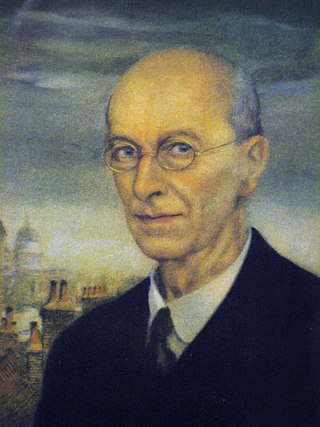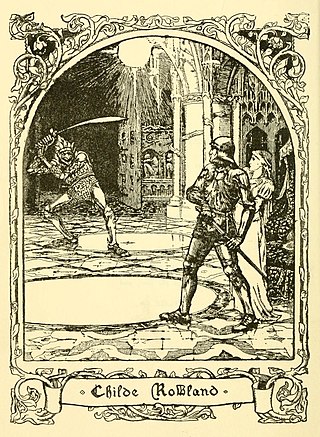In poetry, metre or meter is the basic rhythmic structure of a verse or lines in verse. Many traditional verse forms prescribe a specific verse metre, or a certain set of metres alternating in a particular order. The study and the actual use of metres and forms of versification are both known as prosody.

Poetry, also called verse, is a form of literature that uses aesthetic and often rhythmic qualities of language − such as phonaesthetics, sound symbolism, and metre − to evoke meanings in addition to, or in place of, a prosaic ostensible meaning. A poem is a literary composition, written by a poet, using this principle.
Poetry analysis is the process of investigating the form of a poem, content, structural semiotics and history in an informed way, with the aim of heightening one's own and others' understanding and appreciation of the work.

"Jack the Giant Killer" is a Cornish fairy tale and legend about a young adult who slays a number of bad giants during King Arthur's reign. The tale is characterised by violence, gore and blood-letting. Giants are prominent in Cornish folklore, Breton mythology and Welsh Bardic lore. Some parallels to elements and incidents in Norse mythology have been detected in the tale, and the trappings of Jack's last adventure with the Giant Galigantus suggest parallels with French and Breton fairy tales such as Bluebeard. Jack's belt is similar to the belt in "The Valiant Little Tailor", and his magical sword, shoes, cap, and cloak are similar to those owned by Tom Thumb or those found in Welsh and Norse mythology.

Arthur Rackham was an English book illustrator. He is recognised as one of the leading figures during the Golden Age of British book illustration. His work is noted for its robust pen and ink drawings, which were combined with the use of watercolour, a technique he developed due to his background as a journalistic illustrator.

Raymond Redvers Briggs was an English illustrator, cartoonist, graphic novelist and author. Achieving critical and popular success among adults and children, he is best known in Britain for his 1978 story The Snowman, a book without words whose cartoon adaptation is televised and whose musical adaptation is staged every Christmas.

Harold John Massingham (25 March 1888 – 22 August 1952) was a prolific British writer on ruralism, matters to do with the countryside and agriculture. He was also a published poet.

Childe Rowland is a fairy tale, the most popular version written by Joseph Jacobs in his English Fairy Tales, published in 1890, based on an earlier version published in 1814 by Robert Jamieson. Jamieson's was repeating a "Scottish ballad", which he had heard from a tailor.

"Childe Roland to the Dark Tower Came" is a narrative poem by English author Robert Browning, written on January 2, 1852, and first published in 1855 in the collection titled Men and Women. The poem is often noted for its dark and atmospheric imagery, inversion of classical tropes, and use of unreliable narration. Childe Roland, the only speaker in the poem, describes his journey towards "the Dark Tower", and his horror at what he sees on his quest. The poem ends when Roland finally reaches the tower, leaving his ultimate fate ambiguous.

A verse novel is a type of narrative poetry in which a novel-length narrative is told through the medium of poetry rather than prose. Either simple or complex stanzaic verse-forms may be used, but there will usually be a large cast, multiple voices, dialogue, narration, description, and action in a novelistic manner.
Tweety and the Beanstalk is a 1957 Warner Bros. Merrie Melodies directed by Friz Freleng. The voices were performed by Mel Blanc and June Foray (uncredited). The short was released on July 1, 1957, and stars Tweety and Sylvester.

Weetabix is a breakfast cereal produced by Weetabix Limited in the United Kingdom. It comes in the form of palm-sized wheat biscuits. Variants include organic and Weetabix Crispy Minis (bite-sized) versions. The UK cereal is manufactured in Burton Latimer, Northamptonshire, and exported to over 80 countries. Weetabix for Canada and the United States is manufactured in Cobourg, Ontario, in both organic and conventional versions.

Revolting Rhymes is a 1982 poetry collection by British author Roald Dahl. Originally published under the title Roald Dahl's Revolting Rhymes, it is a parody of traditional folk tales in verse, where Dahl gives a re-interpretation of six well-known fairy tales, featuring surprise endings in place of the traditional happily-ever-after finishes.

"The Horse Gullfaxi and the Sword Gunnföder" is an Icelandic fairy tale, included by Andrew Lang in The Crimson Fairy Book (1903). It was adapted from "das Pferd Gullfaxi und das Schwert Gunnfjödur", a German translation by Josef Poestion in his Islandische Märchen (1884). Poestion acquired the Icelandic text from his contact, "Prof. Steingrimr Thorsteinsson".
A fee is the price one pays as remuneration for rights or services.

"Jack and the Beanstalk" is an English fairy tale. It appeared as "The Story of Jack Spriggins and the Enchanted Bean" in 1734 and as Benjamin Tabart's moralized "The History of Jack and the Bean-Stalk" in 1807. Henry Cole, publishing under pen name Felix Summerly, popularized the tale in The Home Treasury (1845), and Joseph Jacobs rewrote it in English Fairy Tales (1890). Jacobs' version is most commonly reprinted today, and is believed to be closer to the oral versions than Tabart's because it lacks the moralizing.

The Fe-Fi-Four Plus 2 was an American garage rock band formed in Santa Fe, New Mexico, in 1966. Experimenting with inventive vocal arrangements and fuzz-toned guitar melodies, the group was a forerunner in the musical genre of psychedelic rock. The band released what is commonly agreed by music historians as the first psychedelic single by a native New Mexican group, with their first single "I Wanna Come Back ".
"Game Ogre" is the 8th episode of the supernatural drama television series Grimm of season 1 and mid-season premiere, which premiered on January 13, 2012, on NBC. The episode was written by producer Cameron Litvack and consulting producer Thania St. John, and was directed by Terrence O'Hara.

Fe, Fi, Fo, Fum, and Phooey were five mice who traveled to the Moon and circled it 75 times on the 1972 Apollo 17 mission. NASA gave them identification numbers A3305, A3326, A3352, A3356, and A3400, and their nicknames were given by the Apollo 17 crew. The four male mice, one female mouse, and Evans orbited the Moon for a record-setting six days and four hours in the Apollo command module America as Cernan and Schmitt performed the Apollo program's last lunar excursions.













